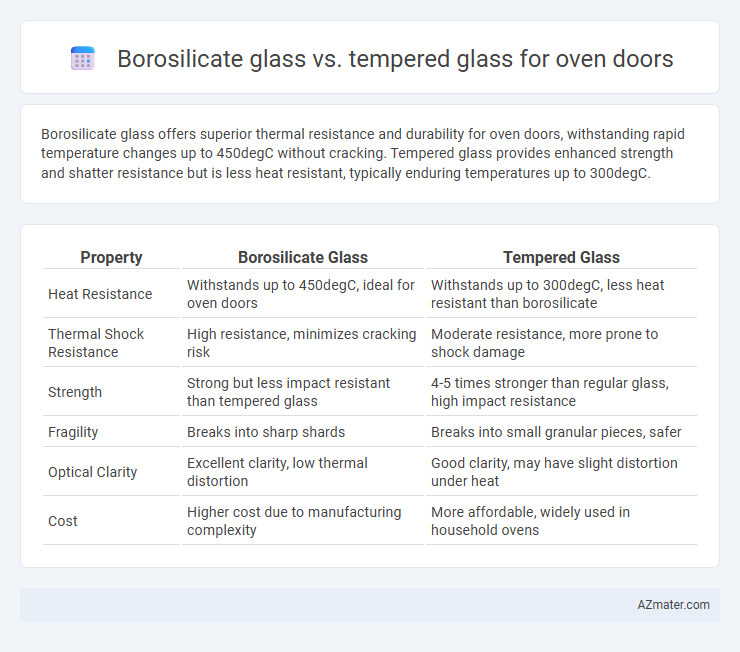Borosilicate glass offers superior thermal resistance and durability for oven doors, withstanding rapid temperature changes up to 450degC without cracking. Tempered glass provides enhanced strength and shatter resistance but is less heat resistant, typically enduring temperatures up to 300degC.
Table of Comparison
| Property | Borosilicate Glass | Tempered Glass |
|---|---|---|
| Heat Resistance | Withstands up to 450degC, ideal for oven doors | Withstands up to 300degC, less heat resistant than borosilicate |
| Thermal Shock Resistance | High resistance, minimizes cracking risk | Moderate resistance, more prone to shock damage |
| Strength | Strong but less impact resistant than tempered glass | 4-5 times stronger than regular glass, high impact resistance |
| Fragility | Breaks into sharp shards | Breaks into small granular pieces, safer |
| Optical Clarity | Excellent clarity, low thermal distortion | Good clarity, may have slight distortion under heat |
| Cost | Higher cost due to manufacturing complexity | More affordable, widely used in household ovens |
Introduction to Oven Door Glass Types
Borosilicate glass and tempered glass are the primary materials used for oven doors due to their heat resistance and durability. Borosilicate glass offers superior thermal shock resistance, making it ideal for rapid temperature changes common in ovens. Tempered glass, on the other hand, provides enhanced strength and safety by breaking into small, less harmful pieces if shattered.
What is Borosilicate Glass?
Borosilicate glass is a type of glass known for its exceptional thermal resistance and durability, making it ideal for oven doors that require consistent heat exposure. It contains silica and boron trioxide, which enhance its ability to withstand rapid temperature changes without cracking, unlike standard tempered glass. Borosilicate glass offers superior chemical and thermal stability, ensuring safety and longevity in high-heat cooking environments.
What is Tempered Glass?
Tempered glass is a type of safety glass processed by controlled thermal or chemical treatments to increase its strength compared to normal glass. It is designed to break into small, blunt pieces rather than sharp shards, reducing injury risk when shattered. For oven doors, tempered glass withstands high temperatures and thermal shocks, making it a durable choice for everyday kitchen use.
Heat Resistance Comparison
Borosilicate glass offers superior heat resistance with a thermal tolerance up to 450degC, making it highly suitable for oven doors exposed to rapid temperature changes. Tempered glass withstands temperatures up to approximately 260degC and provides enhanced mechanical strength but is more prone to thermal shock compared to borosilicate glass. Choosing borosilicate glass ensures better durability and safety in high-heat oven environments due to its low thermal expansion coefficient.
Strength and Durability
Borosilicate glass offers exceptional thermal resistance and durability due to its low coefficient of thermal expansion, making it highly resistant to heat shocks in oven doors. Tempered glass provides superior mechanical strength, being four to five times stronger than regular glass, and can withstand sudden impacts and thermal stresses without shattering easily. For oven doors, borosilicate ensures long-term heat durability while tempered glass enhances safety through impact resistance.
Safety Features and Breakage Patterns
Borosilicate glass for oven doors offers superior thermal shock resistance due to its low coefficient of thermal expansion, reducing the risk of sudden breakage during rapid temperature changes, enhancing safety. Tempered glass, while stronger under mechanical stress, shatters into small, blunt fragments upon breakage, minimizing injury hazards. The breakage pattern of borosilicate glass tends to crack but remain largely intact, preventing sharp shards, making both choices suitable with distinct safety characteristics for oven doors.
Thermal Shock Performance
Borosilicate glass exhibits superior thermal shock resistance compared to tempered glass, making it highly suitable for oven doors exposed to rapid temperature changes. Its low coefficient of thermal expansion allows it to withstand sudden heating and cooling without cracking or shattering. Tempered glass, while strong and impact-resistant, is more prone to thermal stress and may fail under extreme temperature fluctuations common in oven environments.
Cost and Availability
Borosilicate glass for oven doors offers superior thermal resistance and durability but tends to cost more due to its specialized manufacturing process. Tempered glass is more widely available and generally cheaper, making it a cost-effective choice for standard ovens. Availability of borosilicate glass is often limited to premium or high-end oven models, whereas tempered glass is the industry standard and easier to source for replacements.
Maintenance and Cleaning
Borosilicate glass offers superior resistance to thermal shock and chemical cleaners, making it easier to clean and maintain without the risk of cracking or discoloration. Tempered glass, while strong and impact-resistant, requires careful handling during cleaning to prevent surface scratches and edge damage that can compromise its integrity. Regular cleaning with mild, non-abrasive detergents helps preserve the clarity and durability of both glass types used in oven doors.
Best Choice for Oven Doors
Borosilicate glass is the best choice for oven doors due to its superior thermal resistance, with a high tolerance to temperature fluctuations up to 450degC, making it ideal for sustained oven use. Tempered glass offers enhanced strength and shatter resistance but has lower thermal shock resistance, typically handling around 250degC to 300degC safely. For safety, durability, and operational efficiency in oven environments, borosilicate glass provides optimal performance by minimizing the risk of breakage and ensuring consistent heat endurance.

Infographic: Borosilicate glass vs Tempered glass for Oven door
 azmater.com
azmater.com